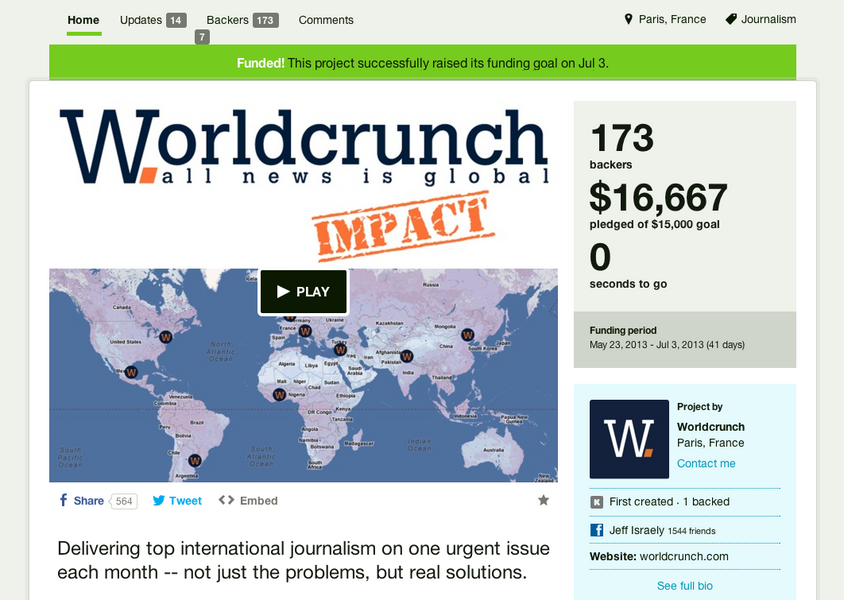Kickstarting journalism: Is crowdfunding the answer?
Loading...
For Jeff Israely, journalism isn't just about reporting the story. It's about making sure someone pays for the reporting.
As the cofounder of Worldcrunch, a global news start-up that translates articles from foreign publications into English, he has experimented with everything from investors to subscriptions to fund the site. In 2013, however, his team wanted to do a more in-depth roundup of "impact" stories focused on critical world issues such as education innovation and the future of farming. To do this, they would need money. So they turned to another source for cash: crowdfunding via a website called Kickstarter.
“It was a different approach to journalism that might inspire people to take an active part in [our project] and support it,” says Mr. Israely. “This is not necessarily the type of journalism that is going to pay for itself.”
Crowdfunding uses the Internet – ironically the very tool that caused an ad revenue vacuum that sent print journalism into a financial tailspin – to solicit fans to pay for projects that have been cut from newsroom budgets, plus generate coveted online buzz in the process. But asking readers to pay for project-style journalism isn’t without its pitfalls, leaving some journalists still searching for a more sustainable future.
Kickstarter and other crowdfunding websites ask creators to explain their project, offer rewards for different levels of donations, and set a deadline for raising money. There are also journalism-specific crowdfunding sites such as Vourno and Spot.us, which started as far back as 2008.
With the dramatic decline in traditional revenue over the last decade, journalism has had to be an early adopter of this innovative funding option. Justin Kazmark, a representative from Kickstarter, says the site has hosted more than 870 journalism projects since the site began in 2009, raising more than $3 million in funds (not counting $2.9 million for periodicals and $2.5 million for radio podcasts). And it looks as if journalists are using it to make up for the hardest-hit areas of media today.
Scanning the selection of Kickstarter journalism projects is like looking at a colorful array of media’s funding woes. Foreign reporting and investigative projects abound, as far off bureaus and labor-intensive investigations have been whittled away in newsroom budgets across the country. Freelancers and documentary filmmakers push their next reporting project as freelance pay has dramatically decreased. Public media outlets and nonprofits, long dependent on donations, hawk special projects that require extensive travel and labor.
But the funding is just one piece of the puzzle. Mr. Kazmark points out that putting a project online also allows it to be more social and shareable, which can engage a wider audience.
“The only way to support their work in the past has been to see the film or buy a magazine – that isn’t a way to be very close to the creator,” he says. “[Kickstarter] has brought the audience very close, to the front row of the process. They get to join the creator on this journey.”
Take, for example, two recently successful Kickstarter campaigns: NPR’s "Planet Money" and ProPublica. "Planet Money," an economics podcast and blog run jointly by National Public Radio and This American Life, raised more than $590,000 (nearly 12 times their original goal of $50,000) to send a team of reporters to follow the making of a T-shirt from the cotton fields in the American South to factories in Indonesia. The donations funded the manufacturing of the T-shirt, which was the reward for any donor backing their trip, and excess funds will go toward training for NPR reporters. Their reports are due to air on "Morning Edition" and "All Things Considered" in November, and they have been updating a Tumblr since August. Investigative journalism nonprofit ProPublica raised $23,000, a thousand more than its goal, to hire an intern to travel the country investigating unpaid internships (yet another issue in the journalism world). The campaign succeeded, and now ProPublica’s intern is on the road, investigating, blogging, and reporting along the way.
Judging from these projects, crowdfunding seems to be working. Worldcrunch, for example, made its $15,000 funding goal in July, and has finished up its first series (called a “dossier”) on education innovation and is about to start on its next focus on “smart cities.”
Though Israely says Kickstarter was key to funding the impact project, he also says the process was a bit painful, and doesn’t want to make hitting up their readers for cash a regular part of their funding strategy.
“It is not for the faint of heart,” he says. “It’s nerve-wracking, it’s a lot of pressure because you’re always staring failure in the face. Success does matter.”
Overall, only 44 percent of Kickstarter projects are funded, and that number drops to 35.4 percent for journalism projects. The reasons why vary from project to project, but Kazmark points out that creators sometimes don’t promote their campaign as loudly as they should or are too vague in describing what their money will go toward. And sometimes it is the platform, rather than the creators, that run into trouble. Spot.us, the first journalism-focused crowdfunding website only raised $7,000 in 2012 versus $120,00 in 2011. PBS MediaShift reported that the reason is a sudden increase in crowdfunding outlets, an acquisition by American Public Media (with a subsequent staff shuffle), and difficulties in making the site financially sustainable as the site’s initial grant money ran low.
Others say difficulties lie in what crowd does the funding. Sasha Chavkin used Kickstarter to fund his investigative reporting trip that looked at kidney disease in Central America, Sri Lanka, and India, and was published with the Center for Public Integrity (he now works for its international offshoot). But Mr. Chavkin points out that the majority of the funds raised came from family, friends, and social networks already in place because of journalism connections.
“There [are] important limitations that people need to understand,” he says. “The Internet does not pay for your project. Your friends and family or professional network pay for your project.”
Like Israely, Chavkin also questions the sustainability of hitting up readers on a case-by-case basis.
“Kickstarter is a valuable tool, but it isn’t a substitute for news organizations funding investigations,” he says.
Perhaps what Kickstarter can offer, as its name suggests, is a kick-start to future endeavors. The Texas Tribune, a nonpartisan, nonprofit news organizations that live-streamed the Wendy Davis filibuster in July, just finished a Kickstarter campaign that raised more than $60,000 to buy live-streaming equipment that it says will allow them to live-stream the upcoming Texas gubernatorial race, as well as daily state-level politics independent from state-run streams.
Despite the crowdfunding challenges, Israely did point out that a key factor in their campaign was implementing sustainability. Any backer that pledged $25 or more was given some level of premium subscriber access to the site, which could convince them to continue subscribing even after their Kickstarter reward expires.
And for his purposes – running a news outlet that focuses on the global perspective many outlets lost when foreign bureaus were shuttered – whatever tells the world’s stories may be worth it.
“It is such an investment of time and money; there are easier ways to get $15,000,” he says. “But as a journalism start-up ... you have to try as many different ways to get that $15,000 as you can."









